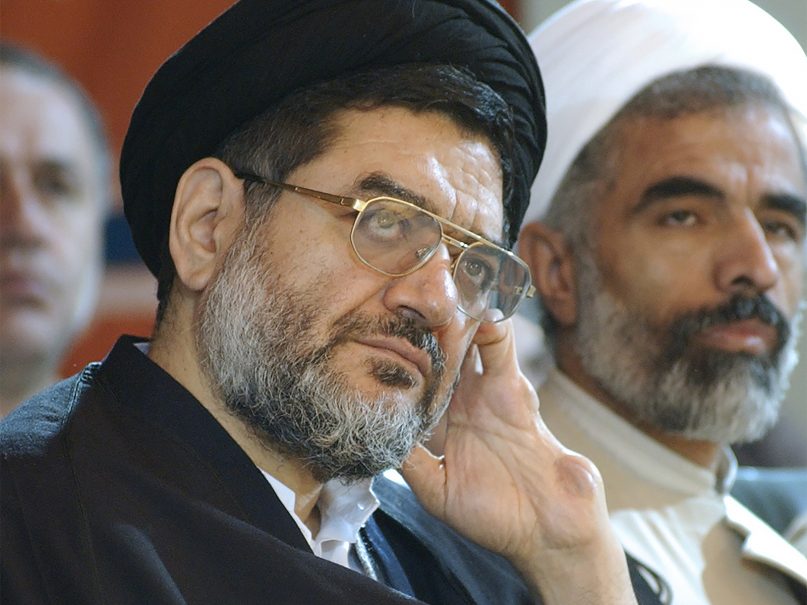(RNS) — Ali Akbar Mohtashamipour, an influential Iranian politician and Shia cleric who survived an assassination attempt in 1984, has succumbed to COVID-19.
Mohtashamipour, 74, was until his death considered one of the last living members of a generation of Iranians who played essential roles in the founding of Iran’s largely theocratic state, following the 1979 revolution that toppled the Shah.
During the 1980s, Mohtashamipour was a confidant and former student of Grand Ayatollah Khomeini, the future Iranian supreme leader. Mohtashamipour, then a young cleric, accompanied Khomeini into exile, first in Najaf, Iraq, and later Paris, France. After exile, Mohtashamipour played an important role in the foundation of Hezbollah as Iran’s ambassador to Damascus from 1982 to 1986 and was the Iranian minister of the interior under Prime Minister Mir-Hossein Mousavi from 1985 to 1989.
Having spent time in the Arab world prior to the 1979 Islamic Revolution, he was one of the new regime’s experts on Palestinian affairs and helped found Iran’s revolutionary guards — a paramilitary organization to defend the regime.
“He was Iran’s ambassador to Syria and was a diplomatic facilitator that oversaw among other things the transfer of Iranian military officials to Lebanon to help train Hezbollah,” said Mohammad Kalantari, an academic at the University of London, Royal Holloway. “At the time, Iran had no ambassador in Beirut, so the Damascus Embassy was critical in coordinating Iranian support to groups fighting the Israeli occupation.”
It was during this period that Syria’s relationship with the Islamic Republic blossomed. During the Iran-Iraq War, Syrian leader Hafez Assad supported Iran in its conflict with Iraqi leader Saddam Hussein, in part due to ideological disputes between two Baathist regimes, said Kalantari, who is the co-director of the university’s Center for Islamic and West Asian studies.
RELATED: DA hard-line stance on Iran endangers Christians. There’s a better way.
Hezbollah, which is considered a terrorist group by the United States and numerous governments around the world, has played a key role in numerous deadly attacks on Americans over the years. The group rose to international prominence in 1983 with the bombing of the U.S. Embassy in Beirut, which killed 63 people, as well as a later bombing of a U.S. Marine Corp barracks, which killed 241 American soldiers, and a subsequent bombing that killed 58 French paratroopers. Both Hezbollah and Iran denied a role in those attacks.
RELATED: Controversial Iraq war battle to be subject of new video game
In 1984, Mohtashamipour lost his hand in an assassination attempt when a bomb hidden inside a book exploded. Israeli spy service Mossad was allegedly behind this attempt on his life.
In later years he remained active in left-leaning and reformist movements inside Iranian politics. He served as an adviser to President Sayyid Mohammad Khatami from 1997 to 1999. In 2006, he participated in an international conference organized by Iranian president Mahmoud Ahmadinejad to deny the historical nature of the Holocaust.
In 2009 he chose to support his former boss, Mir Hossein Mousavi, and Mehdi Karroubi in elections. Though they both lost, the “Green Movement” of 2009 saw massive street demonstrations across Iran to protest the re-election of President Ahmadinejad.
In the fallout, Mousavi was put under house arrest, where he remains to this day. For his part Mohtashamipour largely retired from public life, spending much of his time in the Shia holy city of Najaf, embracing a path of political quietism and spiritual reflection.
Mohtashamipour returned to Iran shortly before his death, where he reportedly died while hospitalized in northern Tehran. With Iranian elections set for next week, figures across the Iranian political spectrum have attempted to seize on Mohtashamipour’s legacy. His path from regime loyalist to soft-opposition figure is increasingly a well-trodden one, with former Iranian President Ahmadinejad recently following a similar political trajectory.
“Mohtashamipour was certainly a key figure in the regime in its initial two decades, but he lost prominence in the last couple of decades,” said Kamran Bokhari, director of analytical development at the Newlines Institute for Strategy and Policy in Washington. “His death symbolizes that the generation of clerics, ideologues, leaders that founded the clerical regime is all but gone. (Supreme Leader) Ali Khamenei and President Hassan Rouhani are among the last of the top figures from the founding generation still around.”
(This post was updated to correct the spelling of Ali Khamenei. We regret the error.)





